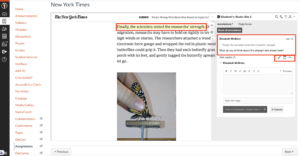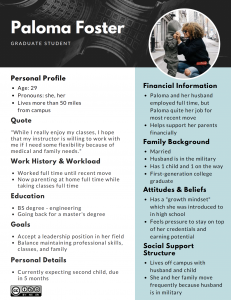In your work as an instructor or instructional designer, what kinds of course design problems have you been trying to solve lately? Perhaps there’s a discussion board assignment that you’d like to make more engaging, or maybe there’s a lab activity that students struggle with.
According to recent research findings published in the journal Nature, “…people are more likely to consider solutions that add features than solutions that remove them, even when removing features is more efficient” (Meyvis, T. and Yoon, H., 2021). In a course design context, this means we will probably reach for something we can add to our course to fix a problem: a shiny new tool we learned about at a conference, an extra video lecture, or an additional step for that lab activity that students struggle with. We do need to include quality tools and fresh media to our courses, certainly. However, because there is so much to cover in any given course, we should strategically subtract all unnecessary elements. The aforementioned Nature article has brought to my attention that I may be regularly neglecting the powerful design move that subtraction offers. As a result of reflecting on that, I’ve collected a few examples of how instructors and instructional designers can use subtraction in course design.
Let’s take a look at a discussion board assignment as an example. Sometimes discussion boards are treated more like formal writing opportunities than discussions. For example, do you require students to not only respond to the prompt but also use a formal style of discourse and cite evidence in accordance with APA style guidelines and do so in a certain number of words? We don’t require students to use APA style or converse with a word count in our in-person discussions, so why would we do this in an online course (Darby, 2020)? Consider subtracting those formal writing requirements for discussion boards, and reserve the APA citations and formal requirements for polished writing assignments. That way, online discussions can be a place to practice and informally grapple with new concepts and ideas the way that face-to-face discussions are. Then, after students have a chance to work through topics in an informal way, they will be ready to try more formal tasks on the topic, such as constructing an argument and appropriately citing evidence according to a particular style guide.
Subtraction example #2: Reduce the frequency of office hours
If you hold office hours at a set time each week, and you notice that few students attend, consider doing away with the set weekly “office hours” altogether. Instead, invite students to make an appointment with you at least once during the term, at a time and in a modality that works well for them, or reduce the frequency of office hours to two or three timely sessions (optional attendance) per term, such as before each exam. Take questions in advance so that students too busy to attend can still benefit from the sessions, and post a recording of the session afterward in an announcement. According to Lowenthal, Dunlap, and Snelson (2017), less frequent but more focused office hours increased participation from students. Lastly, consider renaming your new infrequent office hours to something warm and inviting, such as “Coffee Break” or “Consultations” (Darby, 2019), which students may find more welcoming. Building in plans for facilitation and instructor presence in the early stages of course development allows faculty to focus more on teaching while the course is running and less on reactive problem solving.
Subtraction example #3: Dethrone teaching “folklore”
Teaching “folklore,” which John Warner calls the ineffective “practices handed down instructor to instructor” (p. 207, 2020), shows up uninvited, particularly when you have been assigned a course to teach that you had no hand in developing. One example of teaching folklore is the stubborn assumption that serious scholars are gatekeepers for their fields. Evidence of this exclusionary approach may show up in the form of a stern, overly formal, or cold tone in a syllabus. Consider removing verbiage that conveys a cold tone, since we now know that warm-tone syllabi encourage students to reach out to their professors (Gurung and Galardi, 2021). Another example of this is inflexible class “policies” that reflect an individual instructor’s preferences and not university policies. Consider reviewing the policies stated in the syllabus and delete any that are not aligned with actual university policies. Further, the idea that students must achieve a level of eloquence and scholarly sophistication on par with faculty in order to be considered for a grade of “A” on an assignment is another example of this. Evidence of this type of folklore could be found in rubrics with benchmarks that are nearly impossible to achieve. The element that could be subtracted here is not the rubric, but rather the specific language in the rubric that makes it impossible for students to succeed in the assignment. Neuromyths, which are false beliefs about the brain and learning, could also be included in the category of teaching folklore. If you spot neuromyths in a course, remove them. In summary, if you spot one of these ineffective teaching folklore elements in your course, consider removing the “folklore” item.
For this design challenge, try subtracting ineffective design elements before adding new items to solve course design problems. If you are unsure if something should stay or go, ask yourself what purpose this element serves in the course. It should then become clear whether the item belongs or needs adjustment. Even small adjustments can transform learners’ experiences. What have you removed from your course? Share how the process was for you by leaving a comment.
References:
Blum, S. D. (Ed.). (2020). Ungrading : Why rating students undermines learning (and what to do instead). West Virginia University Press.
Darby, Flower. The Secret Weapon of Good Online Teaching: Discussion Forums 6 ways to lead meaningful class discussions in an asynchronous online forum. August 24, 2020.
Darby, Flower, and James M. Lang. Small Teaching Online : Applying Learning Science in Online Classes, John Wiley & Sons, Incorporated, 2019. ProQuest Ebook Central, http://ebookcentral.proquest.com/lib/osu/detail.action?docID=5780349.
Created from osu on 2022-01-18 23:50:41.
Gasiewski, J.A., Eagan, M.K., Garcia, G.A. et al. From Gatekeeping to Engagement: A Multicontextual, Mixed Method Study of Student Academic Engagement in Introductory STEM Courses. Res High Educ 53, 229–261 (2012). https://doi.org/10.1007/s11162-011-9247-y
Gurung, R. A. R., & Galardi, N. R. (2021). Syllabus Tone, More Than Mental Health Statements, Influence Intentions to Seek Help. Teaching of Psychology. https://doi.org/10.1177/0098628321994632
Lowenthal, P. R., Dunlap, J. C., & Snelson, C. (2017). Live synchronous web meetings in asynchronous online courses: Reconceptualizing virtual office hours. Online Learning , 21 (4). https://doi.org/10
Meyvis, T. & Yoon, H. (2021). Adding is favoured over subtracting in problem solving. Nature.
Shi, T. Debunking Neuromyths and Applications for Online Teaching and Learning: Part 1. February 13, 2019. Ecampus Course Development and Training Blog.
Warner, J. “Wile E. Coyote, the Hero of Ungrading” from Chapter 13 of Ungrading.






